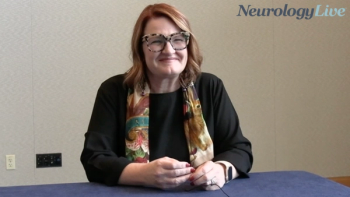
Parkinson Agent Tavapadon Shows Continued Efficacy, Safety in Phase 3 TEMPO-4 Trial
Key Takeaways
- Tavapadon demonstrated a favorable long-term safety profile and motor function improvements in Parkinson's disease patients in the TEMPO-4 study.
- Common treatment-emergent adverse events included nausea, dizziness, and headache, with 14.1% of patients discontinuing due to adverse events.
An interim analysis from TEMPO-4, presented as a late-breaker at MDS 2025, showed that tavapadon showed sustained long-term safety in Parkinson disease.
New late-breaking interim data from TEMPO-4, a phase 3 open-label extension study, revealed that tavapadon (AbbVie), an investigational selective dopamine D1/D5 receptor partial agonist, maintained a favorable long-term safety profile, in addition to improvements seen in motor function, among patients with Parkinson disease (PD).1
TEMPO-4 is an open-label trial of tavapadon in patients with PD who completed the previous TEMPO-1 (NCT04201093), TEMPO-2 (NCT04223193), or TEMPO-3 (NCT04542499) trials, as well as de novo participants with PD on a stable dose of levodopa. In the study, patients received tavapadon at doses of either 5 or 15 mg over a 58-week period (85 total weeks of exposure for active rollover participants), followed by a 10-day safety/withdrawal assessment period, and a 20-day safety follow-up period.
The interim analysis, presented as a late-breaker at the
Led by
Throughout the study, those who stayed on tavapadon continued to show stable motor improvements, while de novo participants and those who crossed over from placebo demonstrated improvements in motor function with continued treatment. Overall, tavapadon was considered safety, with no new safety signals identified, including vital signs or laboratory/electrocardiogram findings.
In the interim analysis, 14.1% of patients discontinued the study drug because of TEAEs. Outside of the aforementioned TEAEs, there were a few safety topics of special interest, including reports of hallucination (6.3%), somnolence (4.6%), hypotension (4.1%), orthostatic hypotension (3.7%), and impulse control disorders (1.4%).
READ MORE:
AbbVie is currently trying to advance tavapadon as a treatment for PD, having filed its
TEMPO-3, the most notable of the trials, was the first to report out data in April 2024. In the trial, treatment with tavapadon resulted in a clinically meaningful and statistically significant increase of 1.1 hours of total ON time without troublesome dyskinesia compared with treatment with levodopa and placebo (1.7 h vs 0.6 h; P <.0001). At the time of the data readout, Cerevel Therapeutics–which was later acquired by AbbVie–reported there was also a statistically significant reduction in OFF time in the tavapadon arm, which was a key secondary end point.3
The TEMPO-1 study evaluated tavapadon’s efficacy and safety as a standalone therapy for Parkinson disease across two fixed daily doses—5 mg and 15 mg—in 529 adults aged 40 to 80 years. Results, shared by AbbVie in September 2024, demonstrated meaningful improvements in motor and daily function. Both dosing arms achieved statistically significant reductions from baseline in Movement Disorder Society–Unified Parkinson’s Disease Rating Scale (MDS-UPDRS) Parts II and III scores compared with placebo (placebo: +1.8; 5 mg: –9.7; 15 mg: –10.2; P < .0001), reinforcing tavapadon’s potential as an effective monotherapy in early PD.4
By December 2024, AbbVie released findings from the TEMPO-2 trial, which further supported tavapadon’s therapeutic value. Among 304 participants receiving monotherapy, those treated with the drug showed significant and clinically relevant improvements in combined MDS-UPDRS Parts II and III scores at 26 weeks compared with placebo (placebo: –1.2; tavapadon: –10.3; P < .0001). Notably, patients also exhibited enhanced performance in the motor aspects of daily living, adding to the growing body of evidence for tavapadon’s benefit in PD management.
Earlier this year, NeurologyLive® released an Insights video series featuring Daniel E. Kremens, MD, JD, vice chair of education and codirector of the Movement Disorders Program at Thomas Jefferson University. In the discussion, part of Exploring New Frontiers: Insight Into Emerging Parkinson Disease Treatments, Kremens reviewed the evolving therapeutic landscape for Parkinson disease, highlighting agents such as tavapadon, NeuroDerm’s ND0612 pump, and Cerevance’s CVN424, along with ongoing advancements in stem cell and gene therapy research.
Watch the video below to hear Dr. Kremens share his perspective on the future of Parkinson disease treatment:
REFERENCES
1. Pahwa R, Dhall R, Mari Z, et al. LBA-17: TEMPO-4: A Phase 3 Open-Label Trial to Investigate the Safety and Efficacy of Long-term Administration of Tavapadon in People With Parkinson’s Disease. Presented at: 2025 MDS Congress; October 5-10; Hawaii. ABSTRACT LBA-17.
2. AbbVie Submits New Drug Application to U.S. FDA for Tavapadon for the Treatment of Parkinson's Disease. September 26, 2025. Accessed October 16, 2025. http://news.abbvie.com/2025-09-26-AbbVie-Submits-New-Drug-Application-to-U-S-FDA-for-Tavapadon-for-the-Treatment-of-Parkinsons-Disease
3. Cerevel Therapeutics announces positive topline results for tavapadon in phase 3 adjunctive trial for people living with Parkinson disease. Cerevel Therapeutics. April 18, 2024. Accessed October 16, 2025. https://www.globenewswire.com/news-release/2024/04/18/2865216/0/en/Cerevel-Therapeutics-Announces-Positive-Topline-Results-for-Tavapadon-in-Phase-3-Adjunctive-Trial-for-People-Living-with-Parkinson-s-Disease.html
4. AbbVie Announces Positive Topline Results from Phase 3 TEMPO-1 Trial Evaluating Tavapadon as a Monotherapy for Parkinson's Disease. News release. September 26, 2024. Accessed October 16, 2025. https://news.abbvie.com/2024-09-26-AbbVie-Announces-Positive-Topline-Results-from-Phase-3-TEMPO-1-Trial-Evaluating-Tavapadon-as-a-Monotherapy-for-Parkinsons-Disease
5. AbbVie Announces Positive Topline Results for the Phase 3 TEMPO-2 Trial Evaluating Tavapadon as a Monotherapy for Parkinson's Disease. News Release. AbbVie. Published December 9, 2024. Accessed October 16, 2025. https://news.abbvie.com/2024-12-09-AbbVie-Announces-Positive-Topline-Results-for-the-Phase-3-TEMPO-2-Trial-Evaluating-Tavapadon-as-a-Monotherapy-for-Parkinsons-Disease
Newsletter
Keep your finger on the pulse of neurology—subscribe to NeurologyLive for expert interviews, new data, and breakthrough treatment updates.


































